From Boring to Balanced: Transform Your Space with 22 Transitional Living Room Designs
There’s something quietly powerful about a space that feels both new and familiar. You walk in, and everything feels balanced soft fabrics, warm light, and furniture that tells a story without saying a word. That’s the beauty of transitional living rooms: they bridge comfort and elegance so naturally that you never have to choose between cozy and sophisticated.
Maybe you’re tired of rooms that feel too minimal or too ornate. Transitional design lives in that sweet spot where modern edges meet classic warmth. It’s where clean lines touch plush textures, and every piece feels collected rather than decorated. You can relax, host friends, or simply unwind without worrying about trends losing their spark.
If your goal is to create a living room that feels timeless, inviting, and completely yours, these transitional living room ideas will help you get there. You’ll find simple ways to layer color, texture, and personality creating a space that feels balanced, welcoming, and effortlessly stylish.
Blend Classic Lines with Modern Comfort
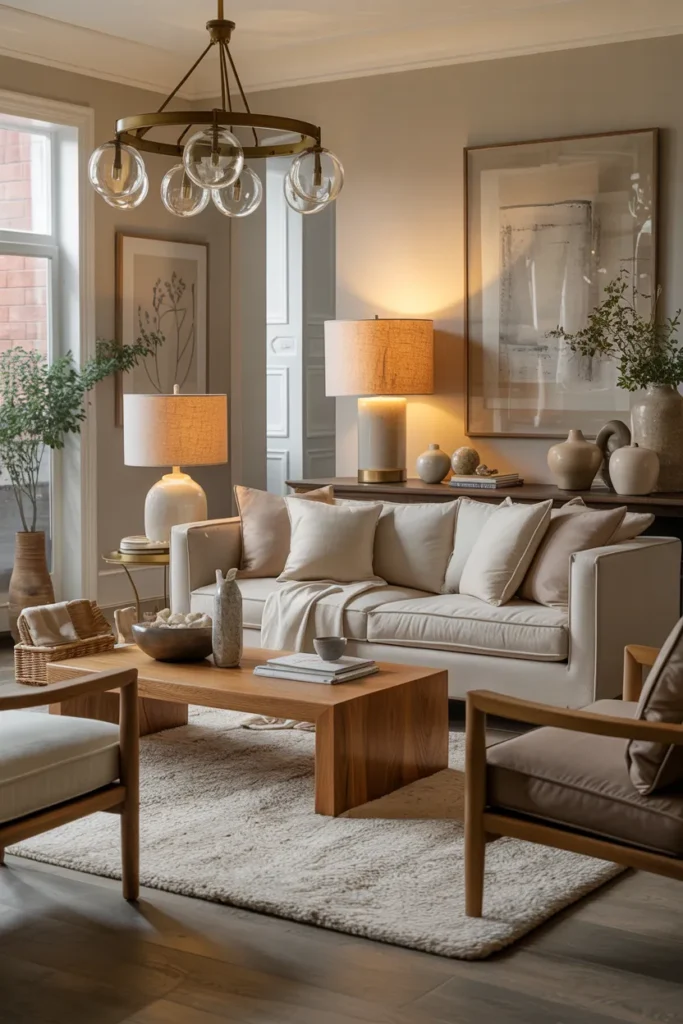
A transitional living room celebrates the best of both worlds traditional charm with modern ease. Picture a plush beige sofa beside a solid oak coffee table. The clean edges meet graceful curves, creating a space that feels calm yet elevated. This mix of structure and softness makes your room timeless and easy to live in.
You can ground everything with a cozy wool rug underfoot and add warmth through textured fabrics. Soft linen drapes, brushed brass lamps, and a velvet accent chair bring tactile depth. Each element contributes to a balanced modern traditional living room design.
To finish, introduce layered art on the walls abstract prints beside botanical sketches. This pairing keeps your space lively and personal. The overall look feels effortless, blending old and new with inviting comfort that never goes out of style.
Soft Neutrals with a Hint of Contrast
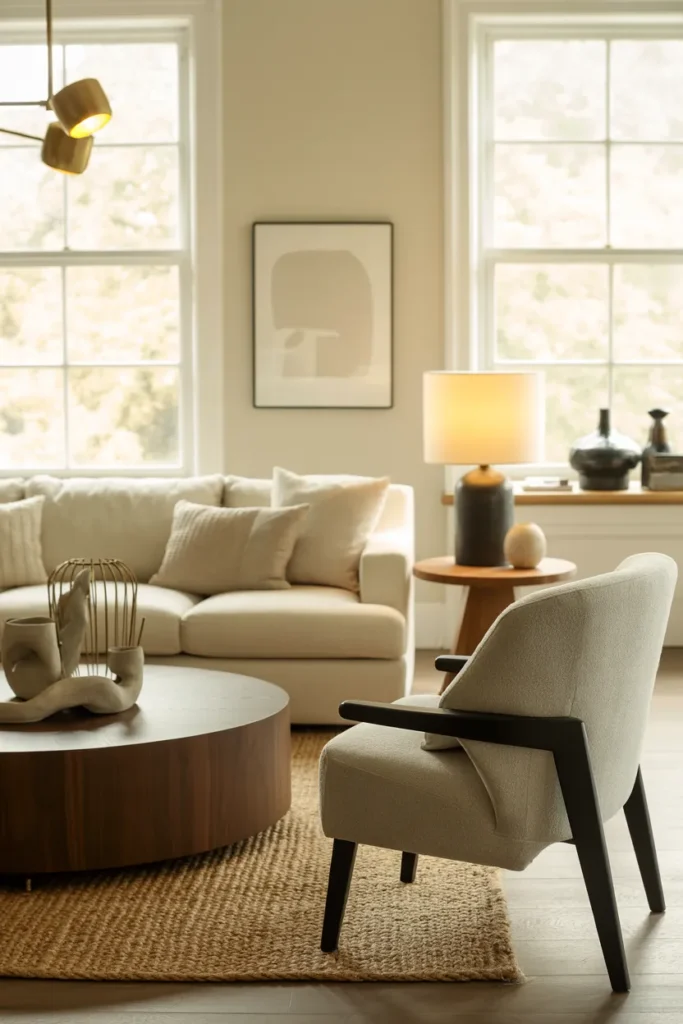
Transitional living room decor often starts with soothing neutral tones. Think creamy whites, warm taupe, and pale gray as your base. These shades create an open, airy feel that pairs beautifully with both rustic and modern elements. Add subtle contrast with espresso wood furniture or a matte black framed mirror. The mix feels calm but sophisticated.
Texture gives life to this neutral palette. Try a woven cotton throw, a soft wool rug, and a ceramic vase for organic appeal. Mix matte and glossy finishes for gentle visual rhythm. Each surface invites touch and light in its own way.
Finish your look with layered lighting. A sleek floor lamp beside a linen-shaded table lamp keeps the mood balanced. This subtle play of tones and textures turns a plain neutral room into a cozy, transitional retreat.
Statement Lighting that Defines the Mood
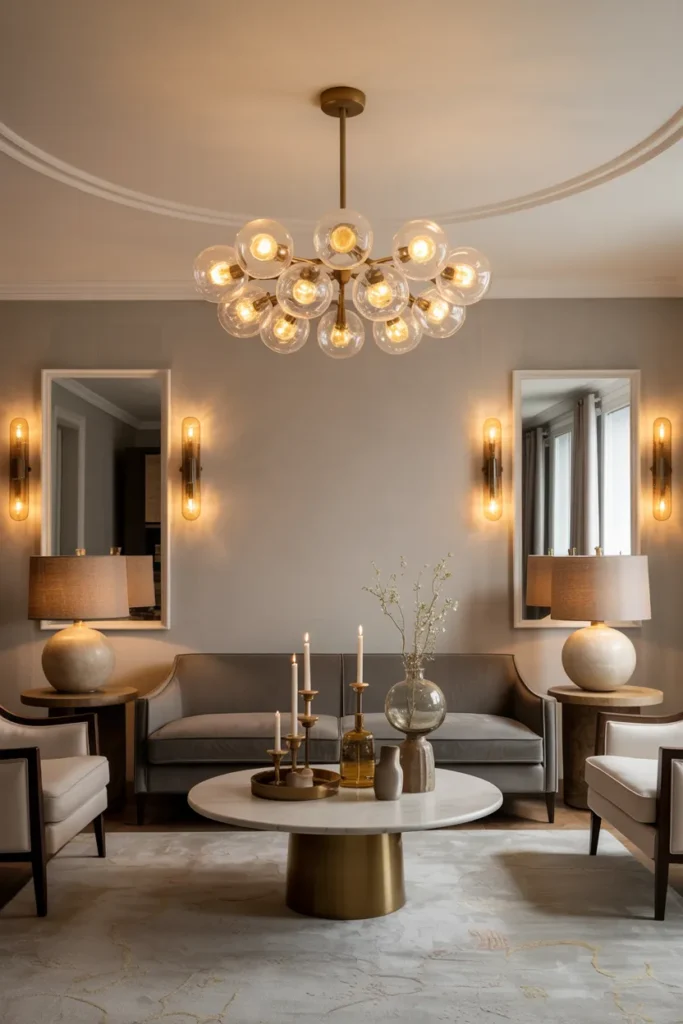
Lighting can completely transform your transitional living room design. Replace basic fixtures with something bold yet timeless a brass chandelier, glass globe pendant, or lantern style piece. Your light becomes a sculptural element that anchors the entire room.
Layer your lighting to match every mood. Combine ceiling lights with sconces and accent lamps. Each piece should serve a clear purpose some for reading, others for a soft evening glow. Warm toned bulbs keep the space inviting while emphasizing natural colors and textures.
As the light changes throughout the day, your space evolves with it. Shadows highlight wood grain, metallic finishes shimmer subtly, and fabrics take on new depth. Great lighting makes your transitional style feel cozy, rich, and full of quiet energy.
Mix of Materials for Visual Interest

The secret to an elevated transitional living room lies in the materials you choose. Pair marble with rattan, wood with glass, and metal with linen. This mix keeps the design dynamic and gives your space a sense of movement. Every piece should feel intentional and tactile.
Start with a main anchor perhaps a linen sofa or a solid oak coffee table. Then, layer in complementary textures like a jute rug, a glass vase, or a leather ottoman. Mixing modern surfaces with rustic finishes brings your space a lived in sophistication.
Keep the balance natural. Too many polished materials can feel cold, while too much texture feels heavy. The goal is harmony where every surface works together to create a warm, transitional living room aesthetic.
Layered Patterns in a Subtle Way
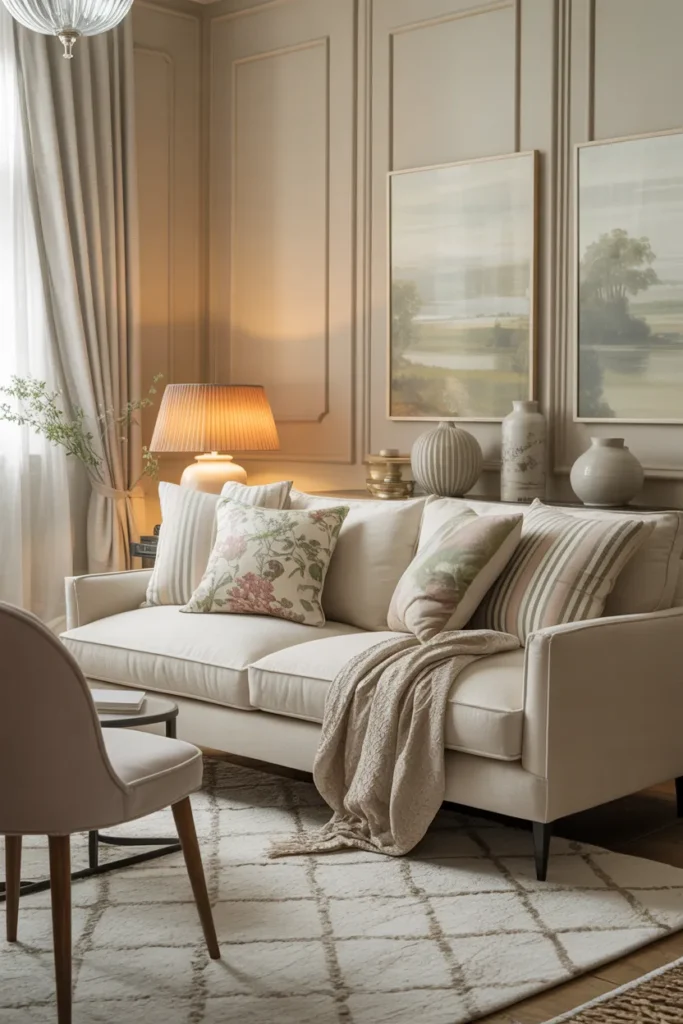
Patterns add quiet personality to transitional interiors. Choose timeless prints like stripes, geometrics, or soft florals in muted tones. They bring life without overpowering the room. You might mix a striped throw pillow, a patterned rug, and curtains with a delicate motif.
Balance your mix by varying the scale. Use a large patterned rug under smaller accent pieces. Keep your color palette cohesive so everything blends easily. The goal is to create visual rhythm while maintaining calm energy in the room.
Add plenty of solids to keep your eyes rested. A neutral sofa or smooth wall allows your prints to stand out gracefully. When layered thoughtfully, patterns make your transitional living room decor feel curated, textured, and full of quiet charm.
Incorporate Warm Wood Tones

Wood brings a grounding warmth that anchors your transitional living room. Choose medium finishes like walnut or oak to balance modern light hues and classic dark ones. A wood coffee table, framed mirrors, or open shelving adds quiet richness that feels familiar and current.
Mix textures for a layered, organic look. Try pairing a wood console with a sleek marble top or woven rattan baskets beside polished brass accents. This blend feels effortless and creates depth without overwhelming your layout.
You’ll notice how the wood softens the space. It connects all your decor elements and adds warmth that synthetic materials can’t match. Natural wood instantly gives your transitional style a relaxed, lived-in appeal that feels timeless.
Use Plush Fabrics for Everyday Comfort

Comfort defines a well styled transitional living room. Choose fabrics that invite you to sit, stretch, and stay awhile. A deep sofa in chenille, velvet, or soft linen sets the tone. Layer it with cotton throws and plush cushions in complementary shades.
Texture makes the difference here. Combine smooth fabrics with nubby weaves to keep things tactile and interesting. Add a faux fur accent pillow or a soft wool pouf to create cozy dimension. Each layer adds warmth and visual softness.
Neutral fabric tones let you play with pattern and light. When sunlight hits the textures, they glow gently, creating a serene mood. Plush fabrics keep your transitional living room decor practical and luxurious without feeling formal.
Add Architectural Details with Molding

Architectural trim instantly elevates a transitional living room. Crown molding, wainscoting, or simple paneling brings dimension to plain walls. You don’t need elaborate carvings clean lines keep it modern while honoring classic craftsmanship.
Paint the molding the same color as your wall for a subtle texture play. This monochrome approach adds shadow and depth without stealing focus. For contrast, try soft ivory on the walls and crisp white on the trim to highlight structure.
These details frame your space beautifully. They guide the eye upward and make the room feel more intentional. Even small upgrades like baseboard or picture-frame molding give your living room a polished, timeless character.
Embrace a Balanced Color Palette
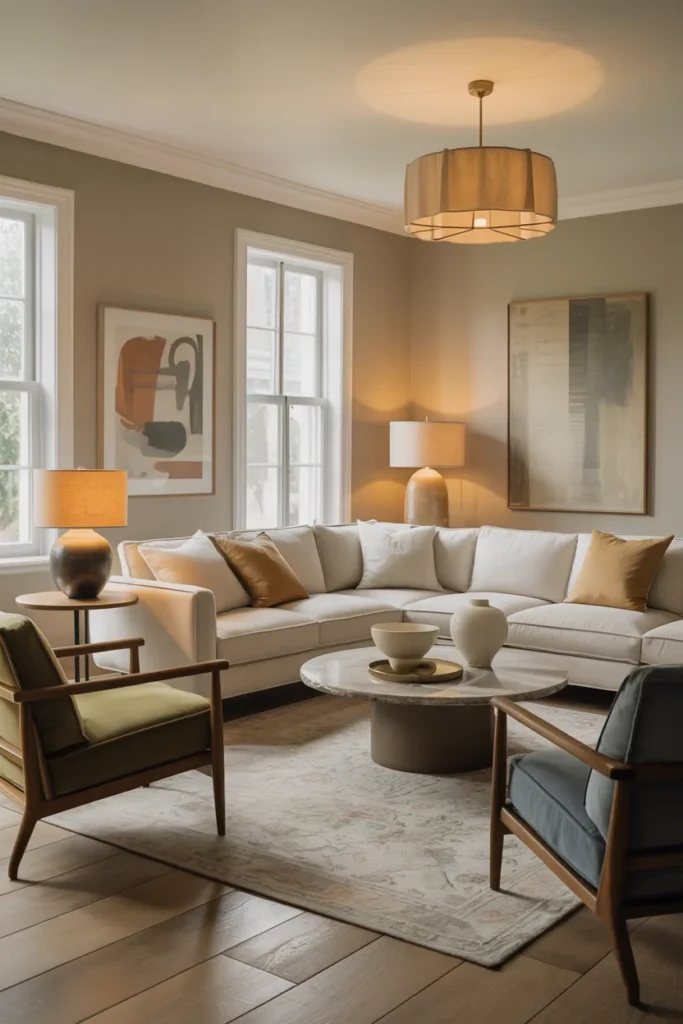
A transitional living room thrives on balance, and your color palette sets the mood. Start with neutrals like cream, greige, and taupe as your base. Then add muted blues, olive greens, or warm terracottas for depth and warmth.
This blend creates harmony between cool and warm tones. Use your accent colors sparingly on pillows, art, or an area rug. Each shade should flow naturally into the next without sharp contrast.
Lighting plays a major role too. Natural sunlight softens these tones during the day, while warm bulbs bring a cozy evening glow. The result is a sophisticated color story that keeps your space fresh and endlessly relaxing.
Create a Focal Point with Art and Accessories
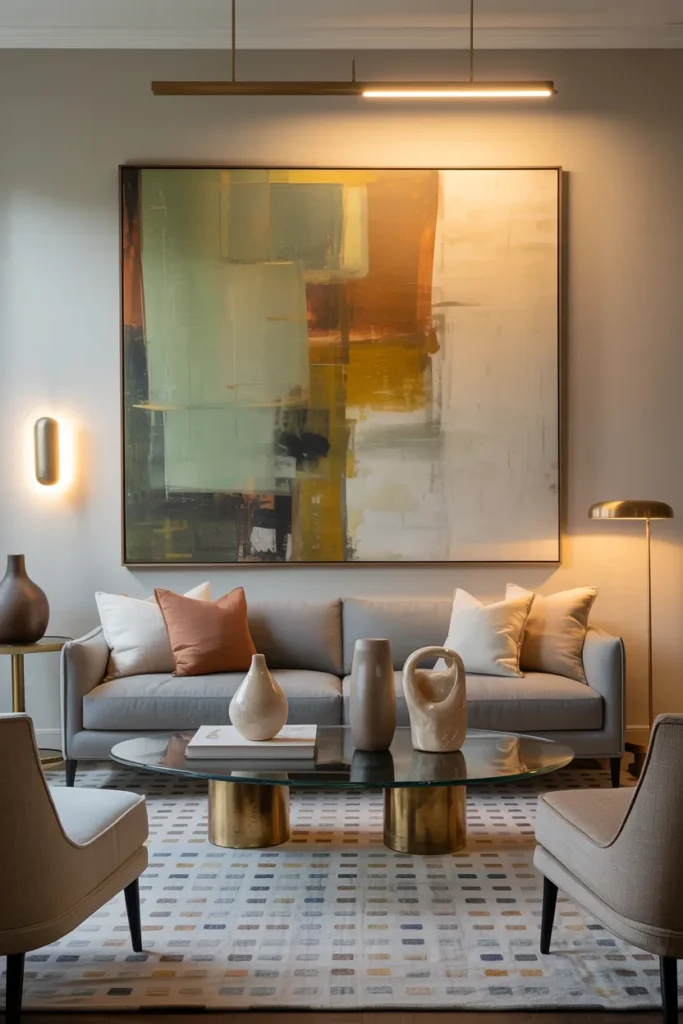
Every transitional living room needs a clear focal point. A large piece of artwork, a stone fireplace, or a styled console table instantly draws attention and defines the mood. Choose one statement, then build around it with complementary pieces.
Use accessories to echo that focal point’s tone and color. If your art features earthy neutrals, pair it with a woven vase or matte pottery. Keep things balanced too many accents can overwhelm the room’s calm energy.
You’ll notice how everything feels connected. A strong focal point grounds the space, giving your transitional decor purpose and direction. It turns your living room into a cohesive story rather than a collection of beautiful pieces.
Layer Lighting for a Warm, Inviting Glow
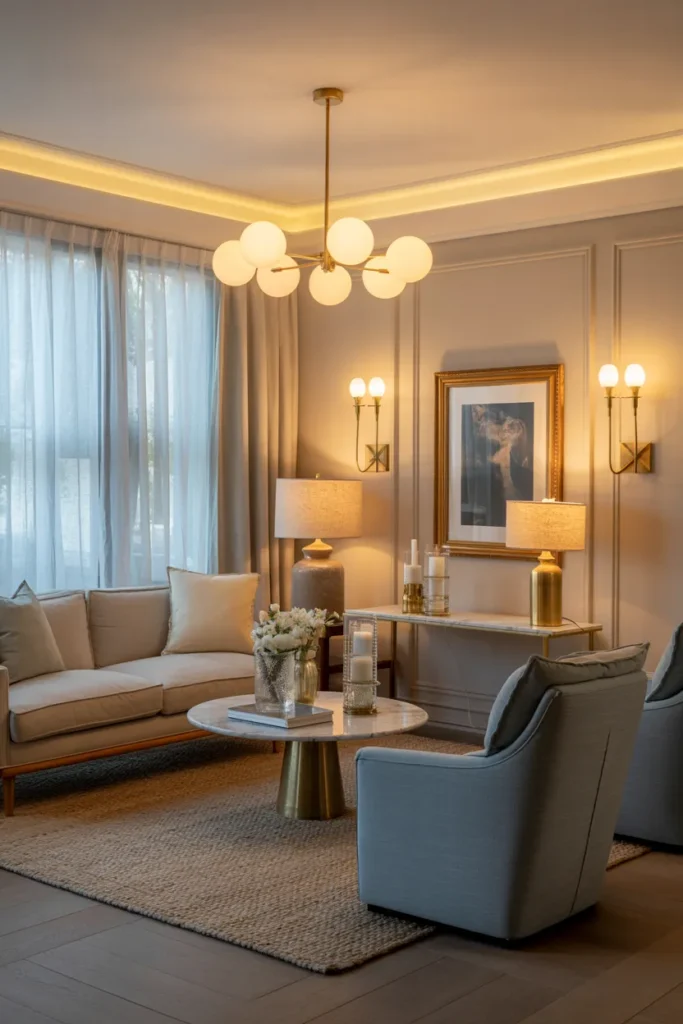
Lighting sets the soul of any transitional living room. Combine ambient, task, and accent lighting to create layers of warmth and balance. A chandelier adds elegance overhead while a pair of lamps brings cozy glow near your seating area.
Place lights where they serve a purpose. Wall sconces work well near art, and recessed lights highlight architectural details. Use warm bulbs to soften the atmosphere and make every material from metal to fabric feel welcoming.
When evening comes, dim the lights for a relaxed, golden tone. Each source blends into a harmonious composition that flatters your furnishings. Layered lighting makes your transitional living room decor feel comfortable, sophisticated, and alive with quiet charm.
Add Natural Greenery for Fresh Energy
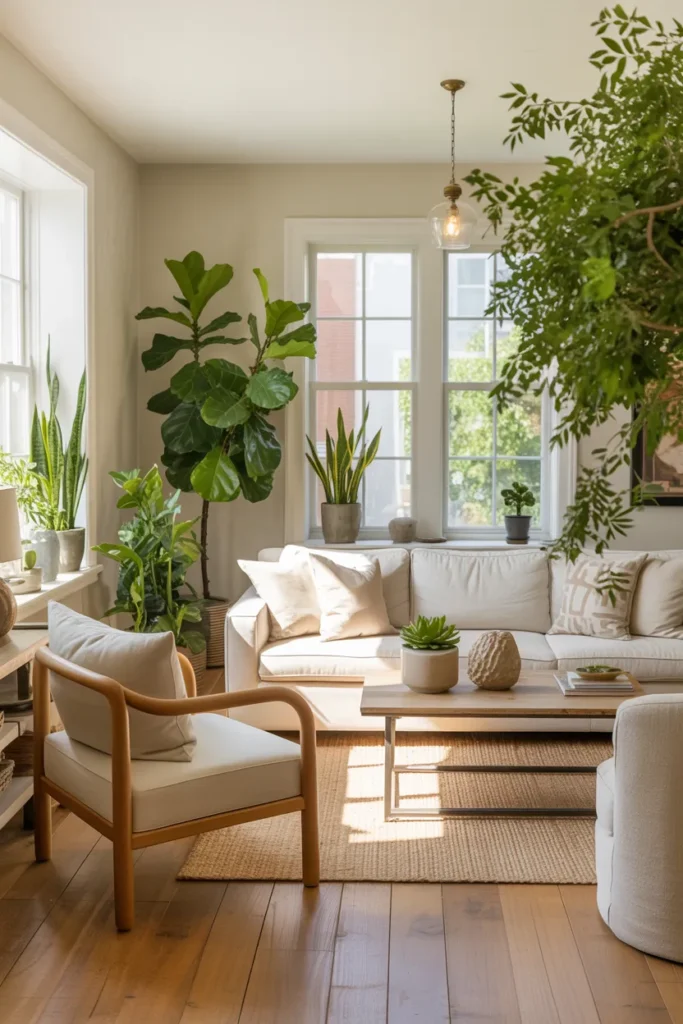
Plants breathe life into your transitional living room design. A tall fiddle leaf fig or a draping pothos adds movement and freshness. Even a single leafy stem in a ceramic vase can soften modern lines and connect your space to nature.
Mix heights and textures for dimension. Pair large potted plants with small tabletop succulents or dried arrangements for seasonal variation. Their organic tones balance clean furniture lines and warm neutral walls.
Greenery doesn’t just look good it changes the mood. It adds oxygen, lightens the visual weight of dark furniture, and introduces subtle color variation. These touches turn your transitional space into a living environment that feels calm and effortlessly refreshing.
Blend Vintage Accents with Modern Furniture

Transitional living rooms feel richer when you mix eras with confidence. Combine a contemporary sofa with an antique chest or a mid century armchair beside a modern glass table. This fusion creates texture and tells your personal story.
Each vintage piece should have purpose. Refinish old wood for a cleaner look or leave patina for character. Pair these finds with soft textiles and neutral backdrops to keep the room balanced, not cluttered.
The result feels layered and authentic. You’ll love how the contrast of new and old brings soul into your design. Every piece contributes meaning, transforming your living room into a curated reflection of timeless style.
Highlight Texture through Layered Rugs
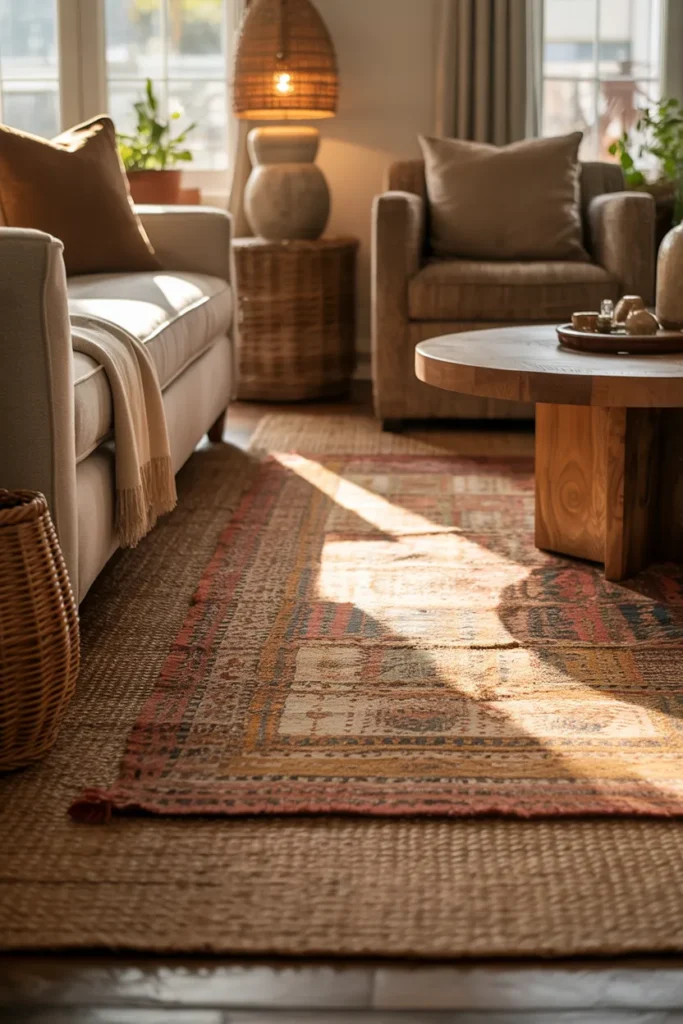
Layering rugs gives your transitional living room depth and comfort. Start with a large neutral base like jute or sisal, then add a patterned or plush rug on top. The contrast in texture and color creates an effortless designer look.
This layering technique anchors furniture and defines open spaces. Use it under your coffee table or sectional to draw attention to your seating zone. Keep patterns subtle so they complement rather than compete.
Footsteps feel softer, and the layered look adds warmth you can see and feel. Rug layering instantly makes your transitional living room decor cozier, more inviting, and visually grounded.
Use Mirrors to Expand and Brighten

Mirrors do more than reflect they transform space. A large framed mirror above the sofa or fireplace doubles natural light and makes the room feel larger. Choose simple frames in wood or brass to echo your other finishes.
Angle mirrors to catch sunlight or highlight your favorite corner. You’ll see how reflections create movement and visual openness. A round mirror softens sharp lines, while rectangular shapes add structure.
Mirrors also act as subtle art pieces. They blend form and function, adding brightness and balance. When placed thoughtfully, mirrors make your transitional living room glow with understated sophistication.
Introduce Metal Accents for Subtle Shine
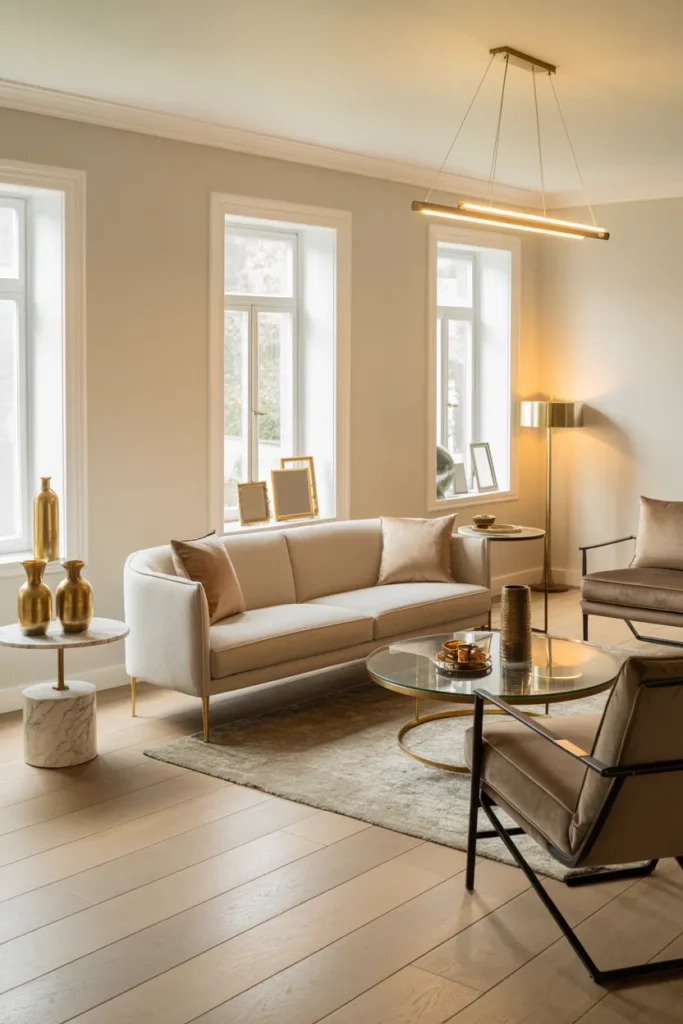
Metal accents give your transitional living room a refined edge. Choose finishes like brushed brass, antique gold, or matte black. They add depth without stealing attention from your soft textures and wood tones.
Use metallics sparingly. A metal framed mirror, brass lamp, or coffee table with steel legs can elevate the entire room. These small touches reflect light beautifully and bring gentle sophistication.
When natural light hits the surfaces, the room glows softly. The metallic reflections balance rustic warmth with modern flair, making your space feel collected and complete without any effort.
Incorporate Built-In Shelving for Style and Function
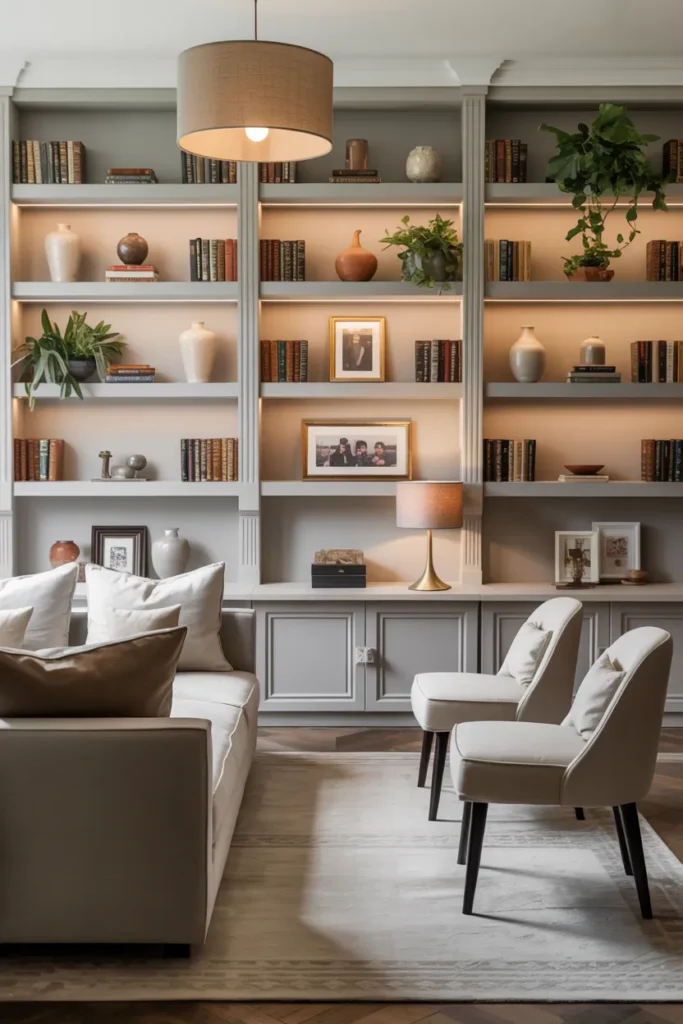
Built-in shelves create structure and purpose in your transitional living room design. They frame your focal wall and offer elegant storage for books, art, and personal treasures. Painted in the same tone as the walls, they blend seamlessly while adding depth.
Style your shelves in layers. Mix vertical and horizontal stacks of books, ceramic vases, and soft greenery for a natural rhythm. Leave some space empty to avoid visual clutter and maintain an airy look.
Built-ins turn your living room into a functional yet sophisticated zone. They add architectural charm, keep things tidy, and showcase your personality through carefully chosen pieces.
Mix Straight and Curved Furniture Lines
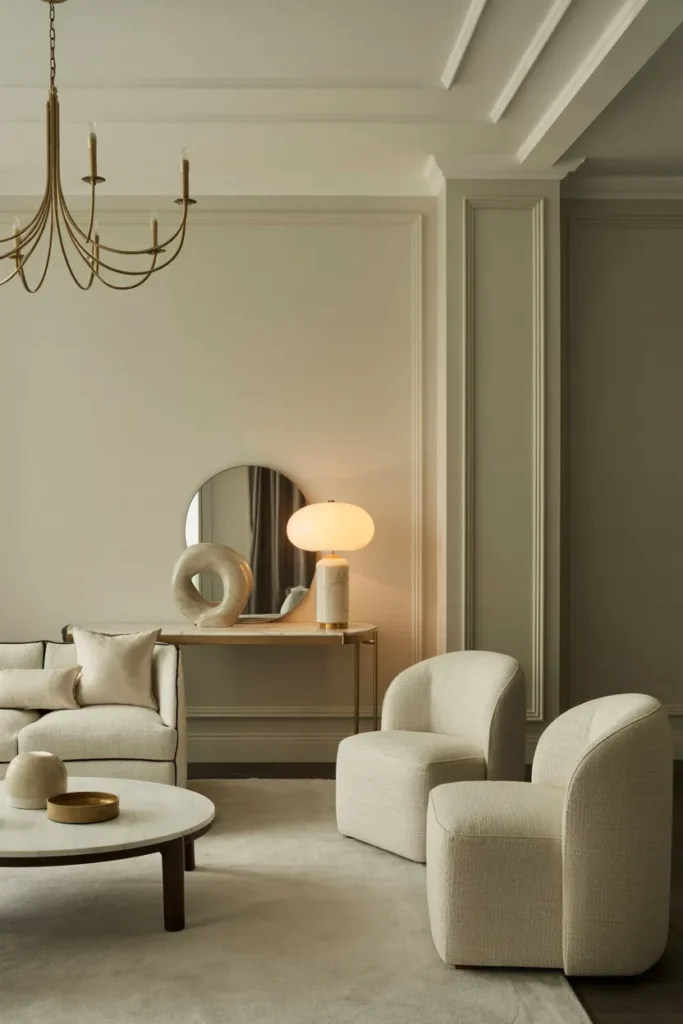
Transitional living rooms thrive on balance, and furniture shape plays a big role. Pair clean-lined sofas with curved armchairs or round coffee tables. The blend creates movement and softens the formality of structured layouts.
Curves add comfort, while straight lines bring order. Together, they make your space approachable yet refined. A round ottoman or arched floor lamp can break monotony and introduce a sense of flow.
This subtle mix keeps the design dynamic. You’ll notice how the room feels more balanced and natural when every angle and curve works together in quiet harmony.
Add Texture through Wall Treatments

Walls offer the perfect canvas for depth in a transitional living room. Use techniques like board and batten, subtle wallpaper, or grasscloth for gentle texture. These elements catch light beautifully and add a layer of sophistication.
Neutral colors work best here creamy whites, greige, or pale sand tones. They keep the texture visible but never overwhelming. Add framed art or mirrors on top for extra visual interest.
You’ll love how tactile walls change the mood. They bring structure, warmth, and character, making your space feel refined and lived in all at once.
Play with Symmetry for Visual Calm
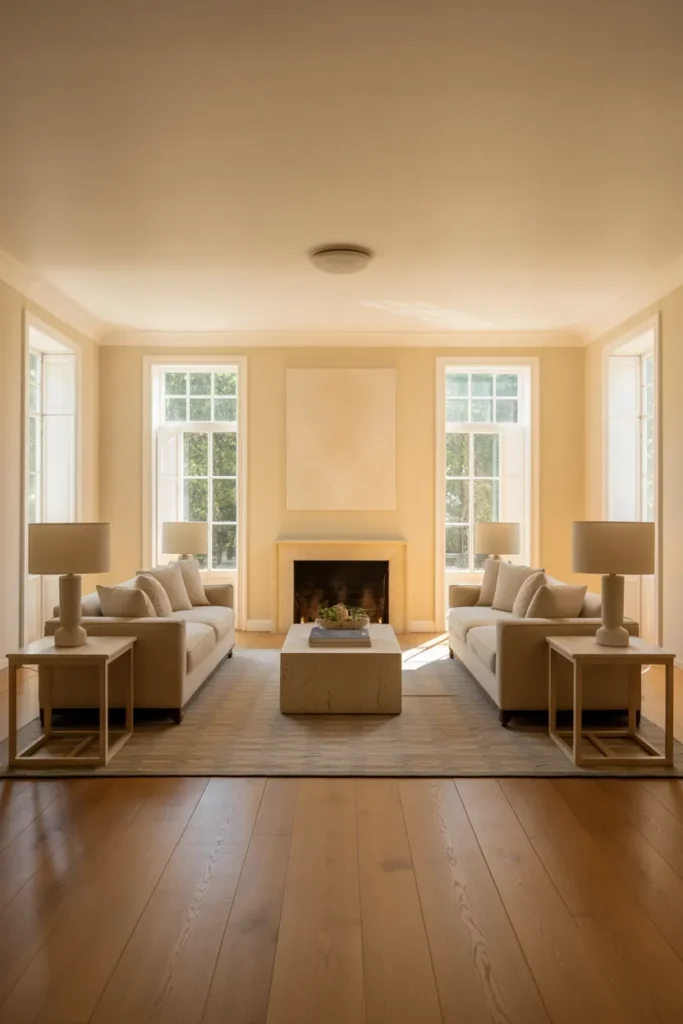
Symmetry creates order and calm in a transitional living room design. Place matching lamps on side tables or twin armchairs across from each other. This balance feels graceful and instantly pleasing to the eye.
Start with one central focal point like a fireplace or console table and build outward evenly. Each element should feel mirrored without being stiff. Add subtle differences in texture or color to keep things natural.
The result is polished yet relaxed. Symmetry gives your living room rhythm, creating a sense of peace that blends traditional charm with modern balance.
Include Statement Seating for Personality
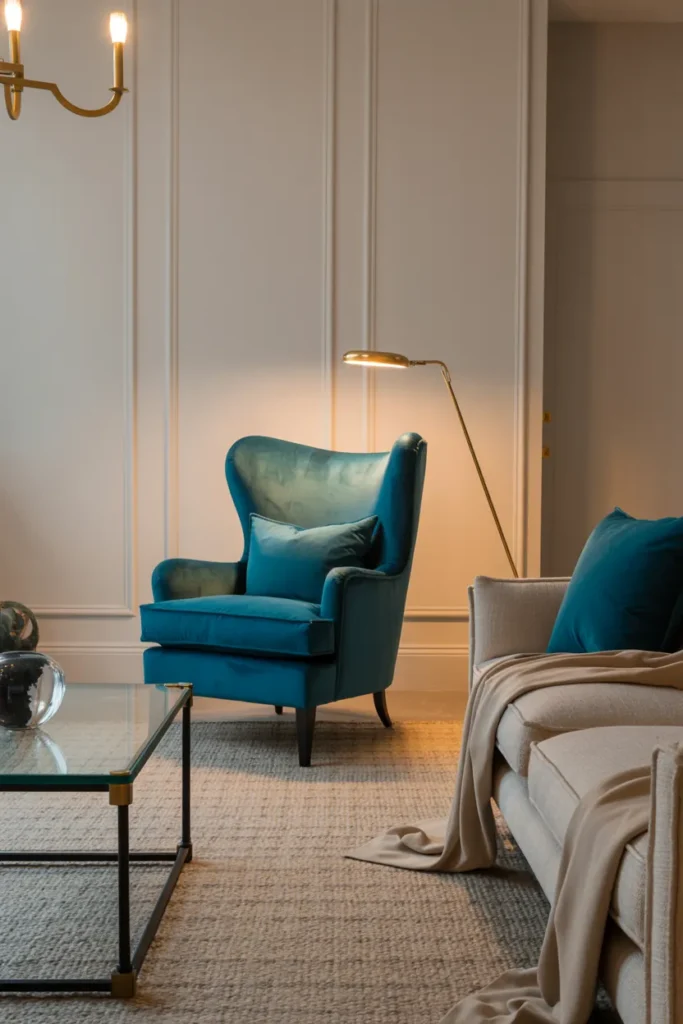
Your seating defines the character of the room. Choose one standout piece a deep velvet armchair, a tufted chaise, or a structured accent chair to set the tone. Its shape and texture become your room’s quiet signature.
Surround your statement chair with neutral furniture to let it shine. Balance its color or fabric with smaller accessories like pillows or throws. This keeps the space cohesive and intentional.
Statement seating anchors your design while showing personality. It’s functional, comfortable, and a simple way to express your taste in a timeless transitional setting.
Keep It Personal with Thoughtful Styling
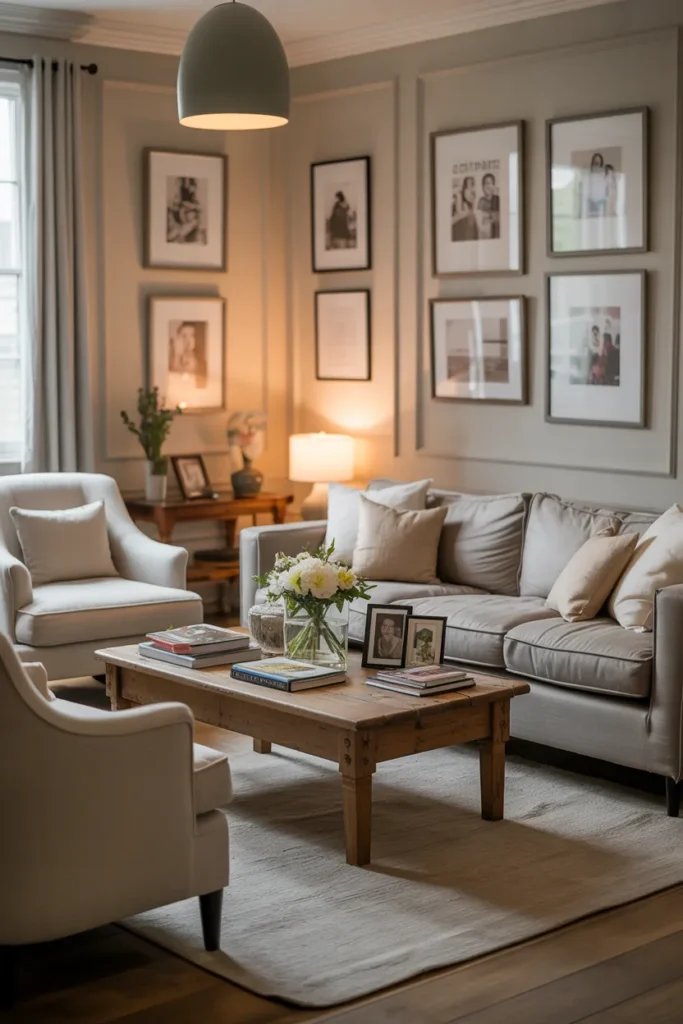
The beauty of a transitional living room lies in how it reflects you. Display your favorite art, books, or travel finds to make the room feel personal. Each object should tell a story and add warmth.
Avoid overcrowding. A few meaningful items on your coffee table or shelves say more than a dozen random accents. Layer them with natural textures like wood and linen for balance.
This human touch turns your living room from a styled space into a lived-in retreat. It’s your personality that completes the look, making the design feel authentic, grounded, and truly yours.
Conclusion
Home feels best when it reflects who you are not what’s trending this season. Transitional living rooms make that possible, blending tradition and modernity into a look that always feels relevant. With layered textures, soft lighting, and thoughtful details, you can craft a space that feels luxurious yet livable every single day.
Each idea shared here opens a door to creativity. Maybe it’s mixing curved lines with straight ones, or bringing in wood warmth beside metal shine. Every small change adds up, transforming your living room into a place where comfort meets quiet elegance.
Your home deserves that balance where timeless design meets your story. A few intentional choices can turn any ordinary space into a living reflection of warmth, style, and everyday joy.

